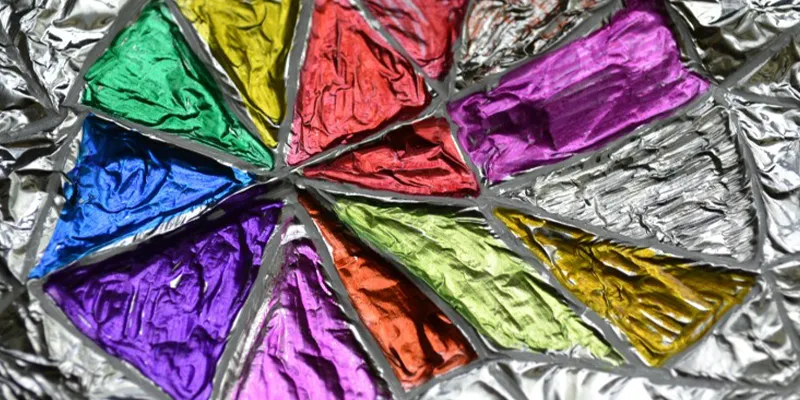Wood stain is a product specifically for penetrating and coloring porous materials like wood. Aluminum foil, however, is a nonporous, smooth metal surface. This raises the question: Can wood stain effectively adhere to or color aluminum foil?

How Does Wood Stain Work?
Sticking wood stain to aluminum foil is difficult and generally ineffective; understanding the process and its limitations can clarify why it fails.
Wood stains contain pigments or dyes in the solvents. These solvents allow the stain to soak into wood fibers. From a scientific point of view, aluminum foil lacks pores, so the stain cannot penetrate its surface. Instead, it will sit on top, causing an uneven or streaky appearance.
Maybe you say, for wood stains to stick to metal, surfaces often require primers or specialized coatings. Wood stain lacks the adhesive properties needed to bond with aluminum foil. Even if applied, the stain may rub off easily or fail to dry properly.
Besides, aluminum foil is thin and flexible. Wood stain, once dried, may crack or flake when the foil is bent or handled.
When wood stain is brushed, sprayed, or rubbed onto aluminum foil, it temporarily adheres to the surface. However, it will quickly flake off as it dries or form streaks.
Why Use Wood Stain on Aluminum Foil?
While wood stain is not suitable for use on aluminum foil, there are experimental or niche scenarios where it might be applied creatively.
- Textured Effects: Use wood stain’s translucent pigments to create abstract patterns or faux rust/patina on foil, paired with other materials like glue, wax, or resin.
- Collage Backdrops: Stain foil sheets for use in collages or sculptures where uneven color or fragility is acceptable.
- Stage/Prop Design: Apply stain to foil for short-term props or backdrops where durability isn’t critical (e.g., theater sets or photo shoots).
- Mock-Ups: Test color schemes or textures on foil before committing to permanent materials like metal or wood.
- Material Science: Showcase how solvents and pigments behave on nonporous vs. porous surfaces in chemistry or art classes.
Other Way for Coloring Aluminum Foil

Coloring aluminum foil requires materials that adhere to its nonporous, flexible surface. Below are professional, tested methods with detailed steps.
- Spray Paint
Best for: large surfaces, solid colors, long-lasting finishes.
Steps:
- Clean the Foil: Wipe with rubbing alcohol to remove oils and debris.
- Sand Lightly (optional): Use fine-grit sandpaper (220+ grit) to roughen the surface slightly for better adhesion.
- Prime: Apply a thin coat of metal primer to prevent peeling. Let it dry.
- Spray Paint: Hold the can 8–12 inches away. Apply 2–3 thin, even coats, allowing 10–15 minutes between coats.
- Seal: Use a clear acrylic sealer for extra durability.
- Acrylic Paint + Sealant
Best for: Detailed designs, custom patterns.
Steps:
- Clean the Foil: Wipe with rubbing alcohol.
- Prime: Brush on a layer of gesso or metal primer to create a porous base. Let it dry.
- Paint: Use acrylic paints and a brush, sponge, or stencil. Apply thin layers to avoid cracking.
- Dry: Let each layer dry completely (20–30 minutes).
- Seal: Coat with clear acrylic varnish or Mod Podge to protect the paint and add flexibility.
- Alcohol Inks
Best for: Translucent effects, gradients, marbling.
Steps:
- Clean the Foil: Wipe with rubbing alcohol.
- Apply Ink: Drop alcohol ink (e.g., Ranger, Jacquard) onto the foil. Tilt the foil to spread the ink or use a brush/blower for patterns.
- Dry: Let air-dry (1–2 minutes).
- Seal: Protect with a clear resin or spray sealant (e.g., Krylon UV-Resistant Clear Coat).
- Permanent Markers/Paint Pens
Best for: Precision work, labels, small details.
Steps:
- Clean the Foil: Wipe with rubbing alcohol.
- Draw/Write: Use oil-based markers (e.g., Sharpie Oil-Based) or acrylic paint pens (e.g., Posca).
- Dry: Let dry 10–15 minutes.
- Seal (optional): Apply clear sealant to prevent smudging.
- Metal Dyes or Patinas
Best for: Professional, permanent color changes (e.g., jewelry, décor).
Steps:
- Clean the Foil: Degrease with acetone or rubbing alcohol.
- Apply Dye: Use a chemical metal dye (e.g., Birchwood Casey Aluminum Black). Follow product instructions (often involves dipping or brushing).
- Rinse and Neutralize: Rinse with water and neutralize with baking soda solution.
- Seal: Coat with wax or clear lacquer to preserve the finish.
- Adhesive Vinyl/Contact Paper
Best for: Temporary color changes or patterns.
Steps:
- Clean the Foil: Ensure the surface is dust-free and dry.
- Cut Vinyl: Use a craft cutter or scissors to shape the vinyl/contact paper.
- Apply: Peel off the backing and press the vinyl onto the foil. Smooth out air bubbles with a squeegee.
- Key Tips for Success
- Surface Prep: Always clean foil with rubbing alcohol.
- Flexibility: Thin paint/sealant layers prevent cracking when bending.
- Durability: Sealants like polyurethane or resin enhance longevity.
Conclusion
Wood stain is not suitable for use on aluminum foil and will not achieve a staining effect. If you want to stain aluminum foil, choose one of the 6 methods above to achieve long-term reliable results.



